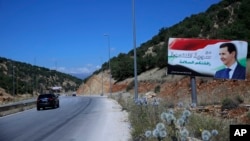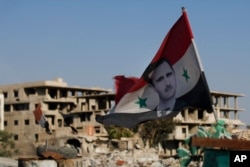Crossing into Syria from neighboring Lebanon, visitors are greeted by giant posters of President Bashar Assad.
The signs proclaim: "Welcome to victorious Syria.''
In the capital of Damascus, many of the checkpoints that for years have snarled traffic are gone. The city is again connected to its sprawling suburbs once held by the opposition, and many former residents and visitors from other parts of Syria fill its streets.
There's a new feeling of hope that an end is near to Syria's seven-year civil war.
"It is almost over,'' Nazeer Habash, 60, said as he walked home near the Hijaz train station in central Damascus. "It is like a child when he starts to walk, taking one step after another, and victory will always be on our side.''
In a central square not far from where rebel shells used to land just a few months ago, families and groups of teenagers took selfies. Children played on a large sculpture spelling out, "I (heart) Damascus.''
The celebratory mood in government-controlled areas stems from successive military advances in the past year.
It is fed by a feeling that Assad, thanks to unwavering support from allies Russia and Iran, has won - or at least has defeated those opposition fighters trying to topple him.
The country has suffered catastrophic damage and some aspects of the conflict are far from over. Still, many Syrians - even some among the opposition - are hoping for some degree of security and stability.
The government now controls major opposition strongholds and key cities like Aleppo, Homs and even Daraa, the southern city where the uprising was born from protests in March 2011.
The vital border crossing with Jordan, sealed for years, is expected to reopen soon after troops recaptured Daraa province, and hopes are high for the resumption of trade and Syrian exports to Arab countries.
Syrians can now drive all the way form the Jordanian border in the south to the central province of Hama on one of the country's most important highways that was severed by insurgents for years in several locations. There is talk that the railway from Damascus to Aleppo might resume operations later this year.
The latest government triumph came this week when rebels agreed to surrender their last pockets of control in Quneitra province in the southwest, opening the way for Assad's forces to re-establish authority along the Israeli frontier.
"The direct threat to Damascus has ended. And since it's the capital, its conditions affect all other parts of the country,'' said Rami al-Khayer, 27, as he sipped a hot beverage with a friend at the famous Nofara cafe in the capital's old quarter.
The scene in devastated areas once controlled by rebels outside Damascus is starkly different. But even amid the ruins there, life is slowly returning to normal, with more businesses reopening and people tricking back.
In Douma, the largest town near Damascus and site of an alleged chemical attack in April, trucks and bulldozers work around the clock to clear the remains of destroyed buildings, sending up clouds of dust.
The operation in Douma is the start of a long process to clear debris from eastern Ghouta, the string of towns and villages east of Damascus that were held by rebels and under siege by government forces for five years. Until the rebels surrendered in the spring, the residents suffered under food shortages, with cases of malnutrition reported. Now, almost everything is available, although prices are still too steep for many.
Two months ago, Mohammed Sleik reopened his sandwich shop near Douma's badly damaged Grand Mosque. During the siege, he had to search for supplies; now they are brought to his door.
"Things are getting better but slowly,'' Sleik said as he prepared a sandwich of french fries in pita bread for a customer at his shop, named Zaman al-Sham - Arabic for "Era of the Levant.''
He said he sells about 170 sandwiches a day, more than three times what he sold before government forces captured the area. Sleik has six employees at his shop, where the menu includes beans, falafel and fries.
Stores are reopening on Douma's main street of Jalaa, and shoppers on a recent day were buying farm produce, clothes and shoes.
In nearby Ain Terma, a town that suffered much heavier destruction than Douma because it is closer to the capital, residents complain that electricity and running water are still scarce. They must rely on generators for power and tanker trucks to deliver water to their homes.
The International Committee of the Red Cross, the Syrian Arab Red Crescent and NGOs such as Oxfam have placed giant red plastic tanks of drinking water every 100 meters in the streets of Ain Terma and Douma so residents can fill containers for free.
"Now we have a state here,'' said Taha Aboud, 60, owner of a shoe repair shop in Ain Terma. Every day, he said, government trucks distribute bread for free.
After being hemmed in for years, Ghouta residents can travel to and from Damascus, although they must register at checkpoints when they enter and leave.
"We were living underground, and now we are above,'' said Samih Hanafi, standing outside his barbershop in Ain Terma.
Suha Touma, a teacher from Hassakeh, brought her daughter Chrystabel to Damascus' landmark Umayyad Square to play in a garden decorated with the colorful "I (heart) Damascus'' sculpture. They traveled from the northeastern province of Hassakeh to spend the summer in Damascus for the first time in years, now that it is safe.
"We see that victory will be very near, and we see the end of the conflict coming soon,'' she said as her daughter ran around the garden.
"I hope that my daughter will become a teacher like myself so that she teaches the future generations to love their country,'' she said with a wide smile.








